Seat Alhambra 2011 Owner's Manual
Manufacturer: SEAT, Model Year: 2011, Model line: Alhambra, Model: Seat Alhambra 2011Pages: 385, PDF Size: 7.92 MB
Page 251 of 385
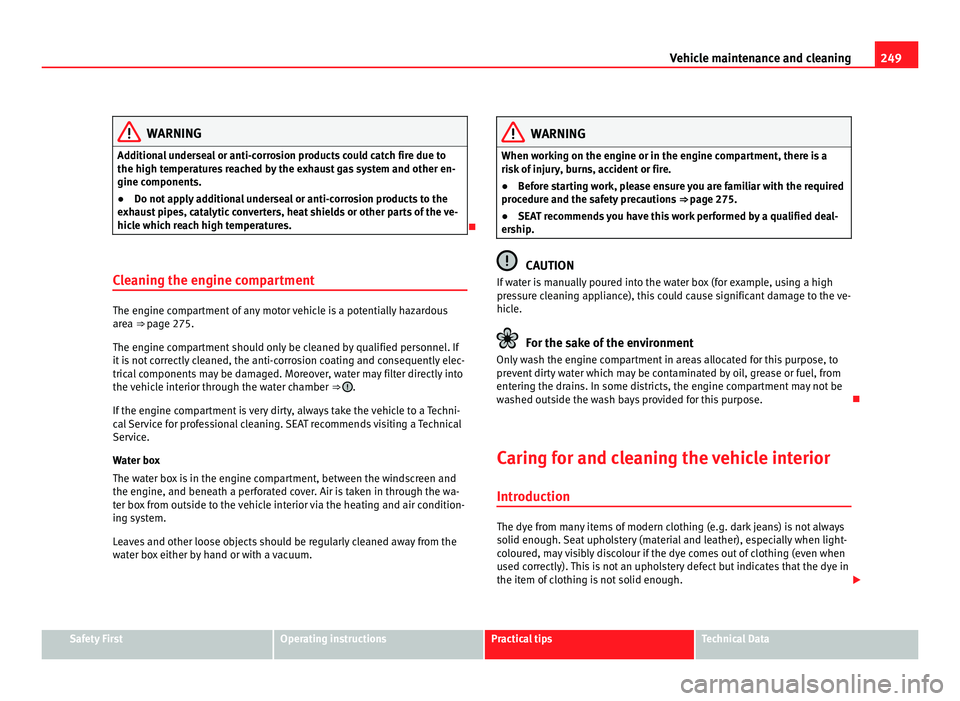
249
Vehicle maintenance and cleaning WARNING
Additional underseal or anti-corrosion products could catch fire due to
the high temper at
ures reached by the exhaust gas system and other en-
gine components.
● Do not apply additional underseal or anti-corrosion products to the
exhau
st pipes, catalytic converters, heat shields or other parts of the ve-
hicle which reach high temperatures.
Cleaning the engine compartment The engine compartment of any motor vehicle is a potentially hazardous
are
a
⇒ page 275.
The engine compartment should only be cleaned by qualified personnel. If
it is not correctly cleaned, the anti-corrosion coating and consequently elec-
trical components may be damaged. Moreover, water may filter directly into
the vehicle interior through the water chamber ⇒ .
If the en gine c
ompartment is very dirty, always take the vehicle to a Techni-
cal Service for professional cleaning. SEAT recommends visiting a Technical
Service.
Water box
The water box is in the engine compartment, between the windscreen and
the engine, and beneath a perforated cover. Air is taken in through the wa-
ter box from outside to the vehicle interior via the heating and air condition-
ing system.
Leaves and other loose objects should be regularly cleaned away from the
water box either by hand or with a vacuum. WARNING
When working on the engine or in the engine compartment, there is a
risk of
injury, burns, accident or fire.
● Before starting work, please ensure you are familiar with the required
procedur
e and the safety precautions ⇒ page 275.
● SEAT recommends you have this work performed by a qualified deal-
ership. CAUTION
If water is manually poured into the water box (for example, using a high
pre s
sure cleaning appliance), this could cause significant damage to the ve-
hicle. For the sake of the environment
Only wash the engine compartment in areas allocated for this purpose, to
prev ent
dirty water which may be contaminated by oil, grease or fuel, from
entering the drains. In some districts, the engine compartment may not be
washed outside the wash bays provided for this purpose.
Caring for and cleaning the vehicle interior Introduction The dye from many items of modern clothing (e.g. dark jeans) is not always
solid enough.
Se
at upholstery (material and leather), especially when light-
coloured, may visibly discolour if the dye comes out of clothing (even when
used correctly). This is not an upholstery defect but indicates that the dye in
the item of clothing is not solid enough. Safety First Operating instructions Practical tips Technical Data
Page 252 of 385
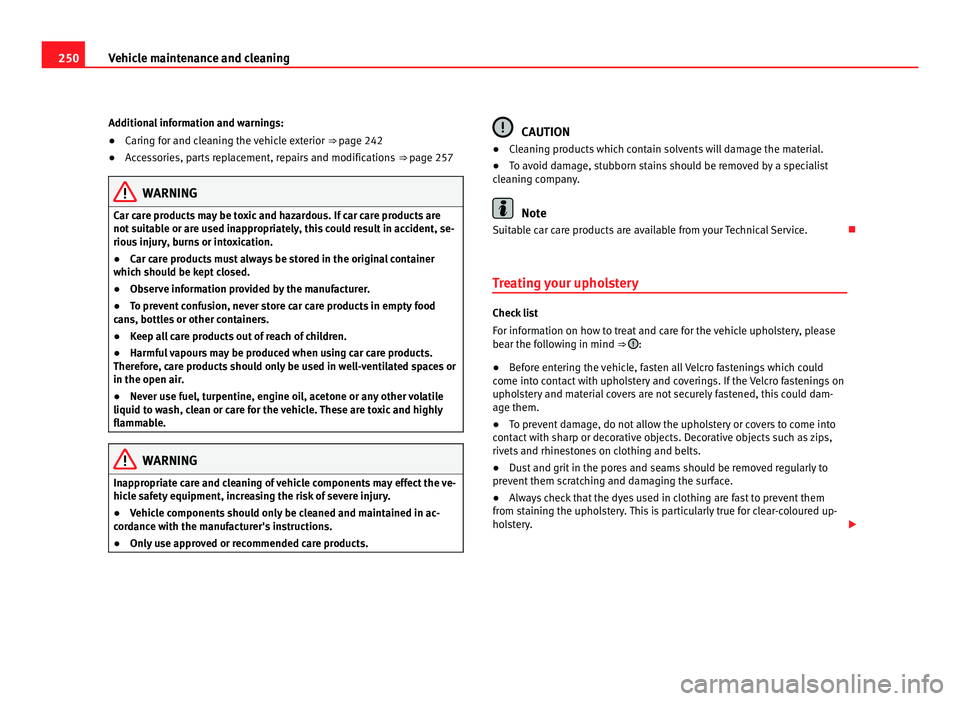
250
Vehicle maintenance and cleaning
Additional information and warnings:
● Caring for and cleaning the vehicle exterior ⇒ page 242
● A
ccessories, parts replacement, repairs and modifications ⇒ page 257WARNING
Car care products may be toxic and hazardous. If car care products are
not s uit
able or are used inappropriately, this could result in accident, se-
rious injury, burns or intoxication.
● Car care products must always be stored in the original container
which shoul
d be kept closed.
● Observe information provided by the manufacturer.
● To prevent confusion, never store car care products in empty food
cans, bottl
es or other containers.
● Keep all care products out of reach of children.
● Harmful vapours may be produced when using car care products.
Therefor
e, care products should only be used in well-ventilated spaces or
in the open air.
● Never use fuel, turpentine, engine oil, acetone or any other volatile
liquid to w
ash, clean or care for the vehicle. These are toxic and highly
flammable. WARNING
Inappropriate care and cleaning of vehicle components may effect the ve-
hicl e s
afety equipment, increasing the risk of severe injury.
● Vehicle components should only be cleaned and maintained in ac-
cord
ance with the manufacturer's instructions.
● Only use approved or recommended care products. CAUTION
● Cleaning products which contain solvents will damage the material.
● To av
oid damage, stubborn stains should be removed by a specialist
cle
aning company. Note
Suitable car care products are available from your Technical Service.
Treating your upholstery Check list
For inf
orm
ation on how to treat and care for the vehicle upholstery, please
bear the following in mind ⇒ :
● Before entering the vehicle, fasten all Velcro fastenings which could
come int o c
ontact with upholstery and coverings. If the Velcro fastenings on
upholstery and material covers are not securely fastened, this could dam-
age them.
● To prevent damage, do not allow the upholstery or covers to come into
contact
with sharp or decorative objects. Decorative objects such as zips,
rivets and rhinestones on clothing and belts.
● Dust and grit in the pores and seams should be removed regularly to
prevent
them scratching and damaging the surface.
● Always check that the dyes used in clothing are fast to prevent them
from st
aining the upholstery. This is particularly true for clear-coloured up-
holstery.
Page 253 of 385

251
Vehicle maintenance and cleaning CAUTION
Failure to observe the instructions in the check list for caring for your up-
hol s
tery could result in damage or discolouration of the upholstery and cov-
ers.
● Always follow the check list and perform the necessary operations. Note
SEAT recommends you take the vehicle to a Technical Service to treat any
stain
s on the upholstery caused by the discolouration of clothing.
Cleaning upholstery, textile covers and Alcantara ®
mat eri
alNormal cleaning
●
Before applying cleaning products, please read the instructions for han-
dling and the w arnin
gs shown on the container.
● The upholstery, textile covers, Alcantara ®
materi
al and mats should be
regularly vacuumed (with vacuum brush).
● We recommend that you use a soft sponge or lint-free, micro-fibre cloth
for normal
cleaning ⇒ .
● Clean Alcantara ®
sur f
aces with a damp lint-free cotton, wool or micro-
fibre cloth used for normal cleaning ⇒ .
General s
uperficial dirt on upholstery and textile covers can be cleaned with
a normal foam cleaning product.
If the upholstery and the material trims are very dirty, we recommend you
have them cleaned by a specialist cleaning form.
Cleaning stains
It may be necessary to clean the whole surface and not only the stain itself.
Especially if the surface has been dirtied through normal use. Otherwise, the stained area may become lighter than the rest of the surface after treat-
ment. Type of stain Cleaning the vehicle
Water-based stains
,
e.g. c off
ee or fruit
juice.
Use a sponge and wipe with a solution of water
and w oo
l wash.
Dry the area gently with a soft dry cloth. Persistent stains
,
e.g. c hoc
olate or
make-up.
Apply cleaning paste a)
dir ectly to the stain and
treat.
Next, rinse with clean water using a sponge or
damp cloth to remove the cleaning product deposits.
Carefully dry the area with an absorbent dry cloth. Grease-based
st
ain
s, e.g. oil or lip-
stick.
Apply a neutral soap or cleaning paste a)
and tr e at
the stain.
Apply absorbent material to loose colorants or par-
ticles of grease.
Then rinse the area with clean water. Take care not
to soak the upholstery. a)
Bile soap can be used as a cleaning paste. CAUTION
● Brushes should only be used to clean the mats and floor mat! Other sur-
f ac
es may be damaged if a brush is used.
● Do not use steam cleaning equipment, as the dirt becomes more incrus-
ted in the mat
erial when steam is applied.
● Alcantara ®
uphols
teries should never be soaked.
● Do not use leather cleaning products, solvents, wax polish, shoe cream,
spot r
emovers or similar products on Alcantara ®
.
● Never use brushes for cleaning damp material as they could damage the
surf
ace.
● Do not use steam cleaning equipment, as the dirt becomes more incrus-
ted in the mat
erial when steam is applied. Safety First Operating instructions Practical tips Technical Data
Page 254 of 385
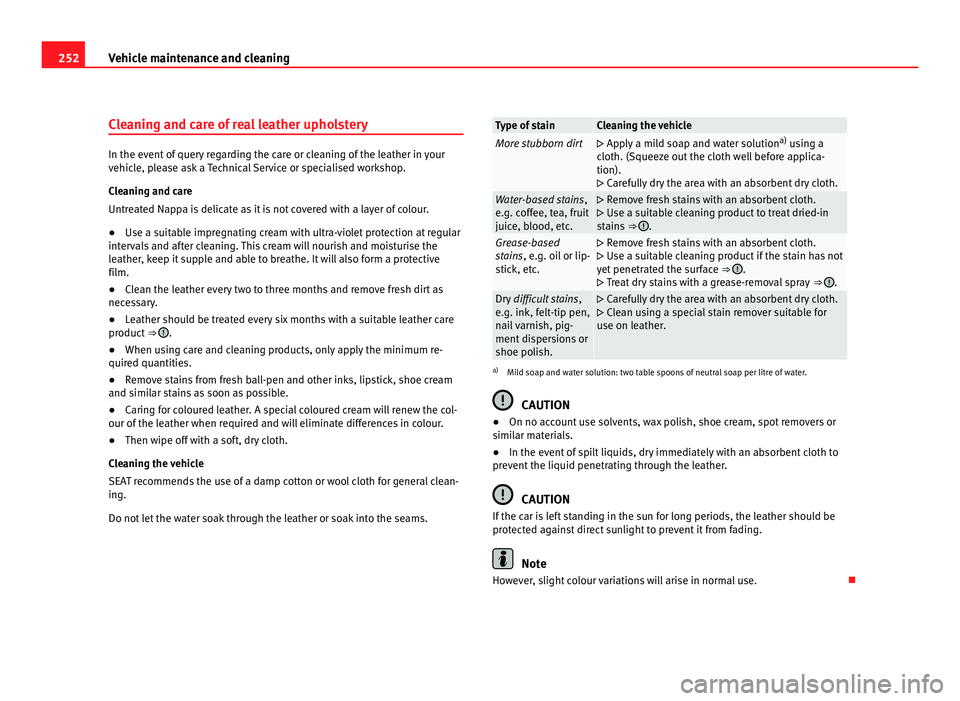
252
Vehicle maintenance and cleaning
Cleaning and care of real leather upholstery In the event of query regarding the care or cleaning of the leather in your
vehic
l
e, please ask a Technical Service or specialised workshop.
Cleaning and care
Untreated Nappa is delicate as it is not covered with a layer of colour.
● Use a suitable impregnating cream with ultra-violet protection at regular
interv
als and after cleaning. This cream will nourish and moisturise the
leather, keep it supple and able to breathe. It will also form a protective
film.
● Clean the leather every two to three months and remove fresh dirt as
neces
sary.
● Leather should be treated every six months with a suitable leather care
product ⇒
.
● When using care and cleaning products, only apply the minimum re-
quired quantitie s.
● R
emove stains from fresh ball-pen and other inks, lipstick, shoe cream
and simil
ar stains as soon as possible.
● Caring for coloured leather. A special coloured cream will renew the col-
our of the le
ather when required and will eliminate differences in colour.
● Then wipe off with a soft, dry cloth.
Cle
aning the vehicle
SEAT recommends the use of a damp cotton or wool cloth for general clean-
ing.
Do not let the water soak through the leather or soak into the seams. Type of stain Cleaning the vehicle
More stubborn dirt
Apply a mild soap and water solution a)
u s
ing a
cloth. (Squeeze out the cloth well before applica-
tion).
Carefully dry the area with an absorbent dry cloth. Water-based stains
,
e.g. c off
ee, tea, fruit
juice, blood, etc.
Remove fresh stains with an absorbent cloth.
U se a s
uitable cleaning product to treat dried-in
stains ⇒ .
Grease-based
st
ain
s, e.g. oil or lip-
stick, etc.
Remove fresh stains with an absorbent cloth.
U se a s
uitable cleaning product if the stain has not
yet penetrated the surface ⇒ .
Tr e
at dry stains with a grease-removal spray ⇒ .
Dry
difficult stains ,
e. g. ink, f
elt-tip pen,
nail varnish, pig-
ment dispersions or
shoe polish.
Carefully dry the area with an absorbent dry cloth.
C l
ean using a special stain remover suitable for
use on leather. a)
Mild soap and water solution: two table spoons of neutral soap per litre of water. CAUTION
● On no acc ou
nt use solvents, wax polish, shoe cream, spot removers or
similar materials.
● In the event of spilt liquids, dry immediately with an absorbent cloth to
prevent
the liquid penetrating through the leather. CAUTION
If the car is left standing in the sun for long periods, the leather should be
prot ect
ed against direct sunlight to prevent it from fading. Note
However, slight colour variations will arise in normal use.
Page 255 of 385
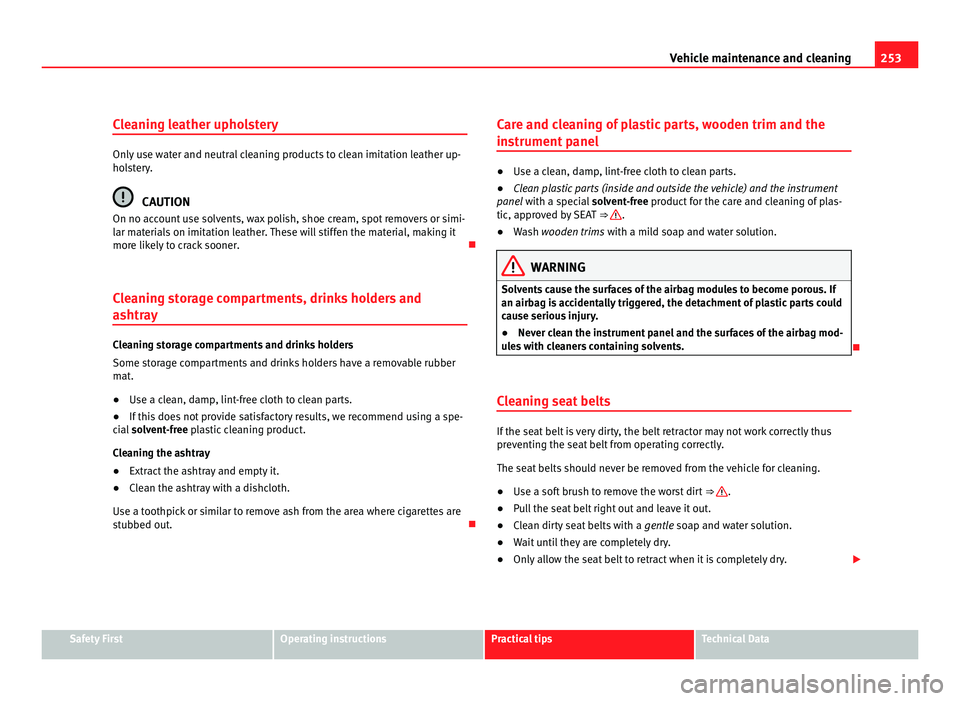
253
Vehicle maintenance and cleaning
Cleaning leather upholstery Only use water and neutral cleaning products to clean imitation leather up-
hol
s
tery. CAUTION
On no account use solvents, wax polish, shoe cream, spot removers or simi-
lar m at
erials on imitation leather. These will stiffen the material, making it
more likely to crack sooner.
Cleaning storage compartments, drinks holders and
ashtr a
y Cleaning storage compartments and drinks holders
Some st
or
age compartments and drinks holders have a removable rubber
mat.
● Use a clean, damp, lint-free cloth to clean parts.
● If this does not provide satisfactory results, we recommend using a spe-
cial
solvent-free plastic cleaning product.
Cleaning the ashtray
● Extract the ashtray and empty it.
● Clean the ashtray with a dishcloth.
Use a toothpic
k or similar to remove ash from the area where cigarettes are
stubbed out. Care and cleaning of plastic parts, wooden trim and the
instrument
panel ●
Use a clean, damp, lint-free cloth to clean parts.
● Clean plastic parts (inside and outside the vehicle) and the instrument
pane l
with a special solvent-free product for the care and cleaning of plas-
tic, approved by SEAT ⇒ .
● Wash wooden trims with a mi
ld soap and water solution. WARNING
Solvents cause the surfaces of the airbag modules to become porous. If
an airbag i s
accidentally triggered, the detachment of plastic parts could
cause serious injury.
● Never clean the instrument panel and the surfaces of the airbag mod-
ule
s with cleaners containing solvents.
Cleaning seat belts If the seat belt is very dirty, the belt retractor may not work correctly thus
prev
entin
g the seat belt from operating correctly.
The seat belts should never be removed from the vehicle for cleaning.
● Use a soft brush to remove the worst dirt ⇒ .
● Pull the seat belt right out and leave it out.
● Clean dirty seat belts with a gentle so
ap and water solution.
● Wait until they are completely dry.
● Only allow the seat belt to retract when it is completely dry. Safety First Operating instructions Practical tips Technical Data
Page 256 of 385
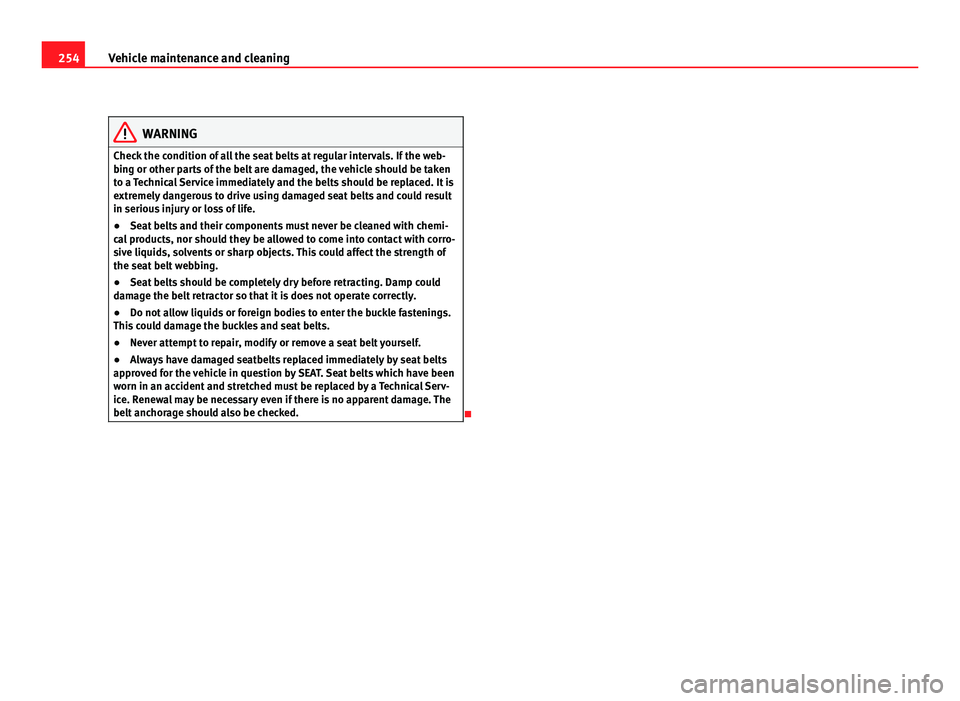
254
Vehicle maintenance and cleaning WARNING
Check the condition of all the seat belts at regular intervals. If the web-
bin g or other p
arts of the belt are damaged, the vehicle should be taken
to a Technical Service immediately and the belts should be replaced. It is
extremely dangerous to drive using damaged seat belts and could result
in serious injury or loss of life.
● Seat belts and their components must never be cleaned with chemi-
cal
products, nor should they be allowed to come into contact with corro-
sive liquids, solvents or sharp objects. This could affect the strength of
the seat belt webbing.
● Seat belts should be completely dry before retracting. Damp could
damag
e the belt retractor so that it is does not operate correctly.
● Do not allow liquids or foreign bodies to enter the buckle fastenings.
This c
ould damage the buckles and seat belts.
● Never attempt to repair, modify or remove a seat belt yourself.
● Always have damaged seatbelts replaced immediately by seat belts
appro
ved for the vehicle in question by SEAT. Seat belts which have been
worn in an accident and stretched must be replaced by a Technical Serv-
ice. Renewal may be necessary even if there is no apparent damage. The
belt anchorage should also be checked.
Page 257 of 385
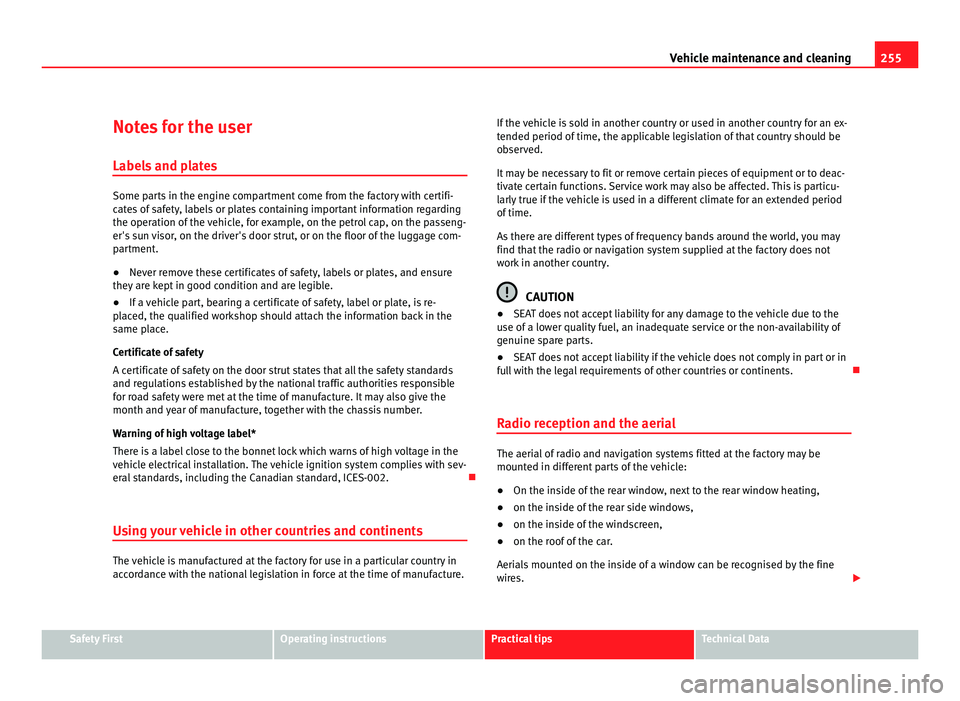
255
Vehicle maintenance and cleaning
Notes for the user Labels and p
latesSome parts in the engine compartment come from the factory with certifi-
cat
e
s of safety, labels or plates containing important information regarding
the operation of the vehicle, for example, on the petrol cap, on the passeng-
er's sun visor, on the driver's door strut, or on the floor of the luggage com-
partment.
● Never remove these certificates of safety, labels or plates, and ensure
they are k
ept in good condition and are legible.
● If a vehicle part, bearing a certificate of safety, label or plate, is re-
plac
ed, the qualified workshop should attach the information back in the
same place.
Certificate of safety
A certificate of safety on the door strut states that all the safety standards
and regulations established by the national traffic authorities responsible
for road safety were met at the time of manufacture. It may also give the
month and year of manufacture, together with the chassis number.
Warning of high voltage label*
There is a label close to the bonnet lock which warns of high voltage in the
vehicle electrical installation. The vehicle ignition system complies with sev-
eral standards, including the Canadian standard, ICES-002.
Using your vehicle in other countries and continents The vehicle is manufactured at the factory for use in a particular country in
acc
or
dance with the national legislation in force at the time of manufacture. If the vehicle is sold in another country or used in another country for an ex-
tended period of time, the ap
plicable legislation of that country should be
observed.
It may be necessary to fit or remove certain pieces of equipment or to deac-
tivate certain functions. Service work may also be affected. This is particu-
larly true if the vehicle is used in a different climate for an extended period
of time.
As there are different types of frequency bands around the world, you may
find that the radio or navigation system supplied at the factory does not
work in another country. CAUTION
● SEAT does not accept liability for any damage to the vehicle due to the
u se of
a lower quality fuel, an inadequate service or the non-availability of
genuine spare parts.
● SEAT does not accept liability if the vehicle does not comply in part or in
ful
l with the legal requirements of other countries or continents.
Radio reception and the aerial The aerial of radio and navigation systems fitted at the factory may be
mount
ed in diff
erent parts of the vehicle:
● On the inside of the rear window, next to the rear window heating,
● on the inside of the rear side windows,
● on the inside of the windscreen,
● on the roof of the car.
Aerials
mounted on the inside of a window can be recognised by the fine
wires. Safety First Operating instructions Practical tips Technical Data
Page 258 of 385
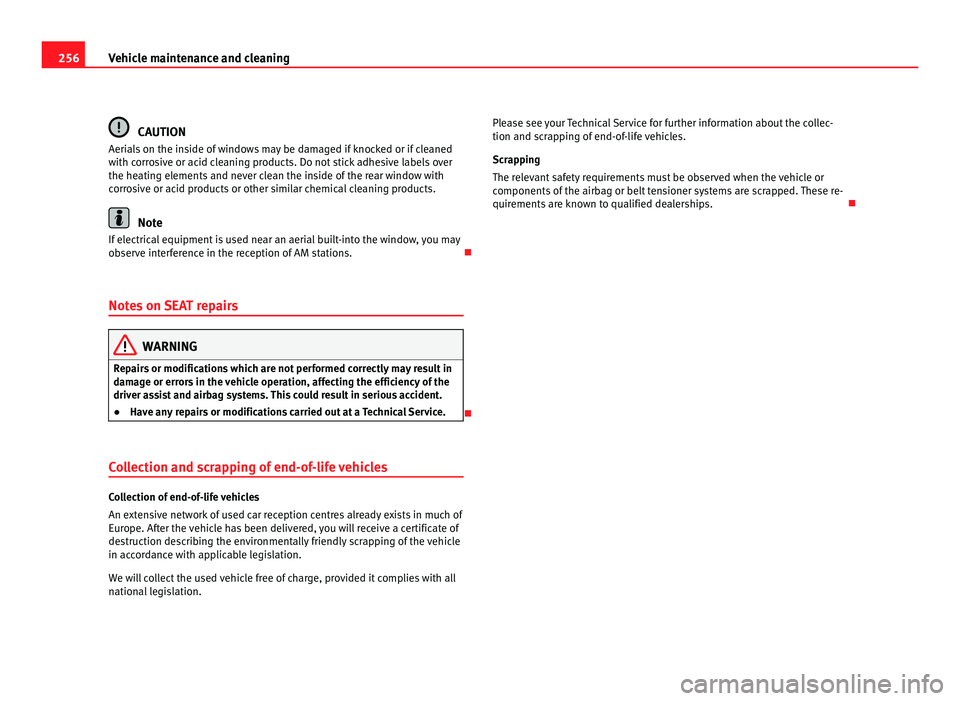
256
Vehicle maintenance and cleaning CAUTION
Aerials on the inside of windows may be damaged if knocked or if cleaned
with c orr
osive or acid cleaning products. Do not stick adhesive labels over
the heating elements and never clean the inside of the rear window with
corrosive or acid products or other similar chemical cleaning products. Note
If electrical equipment is used near an aerial built-into the window, you may
ob ser
ve interference in the reception of AM stations.
Notes on SEAT repairs WARNING
Repairs or modifications which are not performed correctly may result in
dam ag
e or errors in the vehicle operation, affecting the efficiency of the
driver assist and airbag systems. This could result in serious accident.
● Have any repairs or modifications carried out at a Technical Service.
Collection and scrapping of end-of-life vehicles Collection of end-of-life vehicles
An ext
en
sive network of used car reception centres already exists in much of
Europe. After the vehicle has been delivered, you will receive a certificate of
destruction describing the environmentally friendly scrapping of the vehicle
in accordance with applicable legislation.
We will collect the used vehicle free of charge, provided it complies with all
national legislation. Please see your Technical Service for further information about the collec-
tion and scr
apping of end-of-life vehicles.
Scrapping
The relevant safety requirements must be observed when the vehicle or
components of the airbag or belt tensioner systems are scrapped. These re-
quirements are known to qualified dealerships.
Page 259 of 385
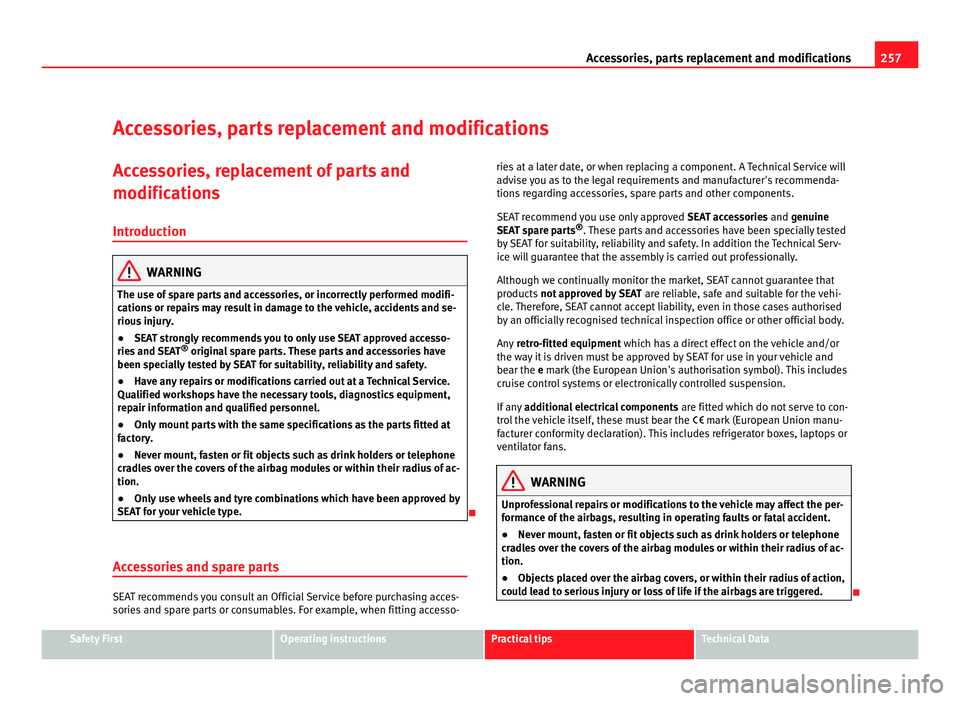
257
Accessories, parts replacement and modifications
Accessories, parts replacement and modifications Accessories, replacement of parts and
modification s
Intr
oduction WARNING
The use of spare parts and accessories, or incorrectly performed modifi-
cation s
or repairs may result in damage to the vehicle, accidents and se-
rious injury.
● SEAT strongly recommends you to only use SEAT approved accesso-
ries and
SEAT ®
original spare parts. These parts and accessories have
been specially tested by SEAT for suitability, reliability and safety.
● Have any repairs or modifications carried out at a Technical Service.
Qualified work
shops have the necessary tools, diagnostics equipment,
repair information and qualified personnel.
● Only mount parts with the same specifications as the parts fitted at
factor
y.
● Never mount, fasten or fit objects such as drink holders or telephone
cra
dles over the covers of the airbag modules or within their radius of ac-
tion.
● Only use wheels and tyre combinations which have been approved by
SEAT f
or your vehicle type.
Accessories and spare parts SEAT recommends you consult an Official Service before purchasing acces-
sories
and s
pare parts or consumables. For example, when fitting accesso- ries at a later date, or when replacing a component. A Technical Service will
advi
se you as to the legal requirements and manufacturer's recommenda-
tions regarding accessories, spare parts and other components.
SEAT recommend you use only approved SEAT accessories and genuine
SEAT spare parts ®
. These parts and accessories have been specially tested
by SEAT for suitability, reliability and safety. In addition the Technical Serv-
ice will guarantee that the assembly is carried out professionally.
Although we continually monitor the market, SEAT cannot guarantee that
products not approved by SEAT are reliable, safe and suitable for the vehi-
cle. Therefore, SEAT cannot accept liability, even in those cases authorised
by an officially recognised technical inspection office or other official body.
Any retro-fitted equipment which has a direct effect on the vehicle and/or
the way it is driven must be approved by SEAT for use in your vehicle and
bear the e mark (the European Union's authorisation symbol). This includes
cruise control systems or electronically controlled suspension.
If any additional electrical components are fitted which do not serve to con-
trol the vehicle itself, these must bear the mark (European Union manu-
facturer conformity declaration). This includes refrigerator boxes, laptops or
ventilator fans. WARNING
Unprofessional repairs or modifications to the vehicle may affect the per-
form anc
e of the airbags, resulting in operating faults or fatal accident.
● Never mount, fasten or fit objects such as drink holders or telephone
cra
dles over the covers of the airbag modules or within their radius of ac-
tion.
● Objects placed over the airbag covers, or within their radius of action,
coul
d lead to serious injury or loss of life if the airbags are triggered.
Safety First Operating instructions Practical tips Technical Data
Page 260 of 385
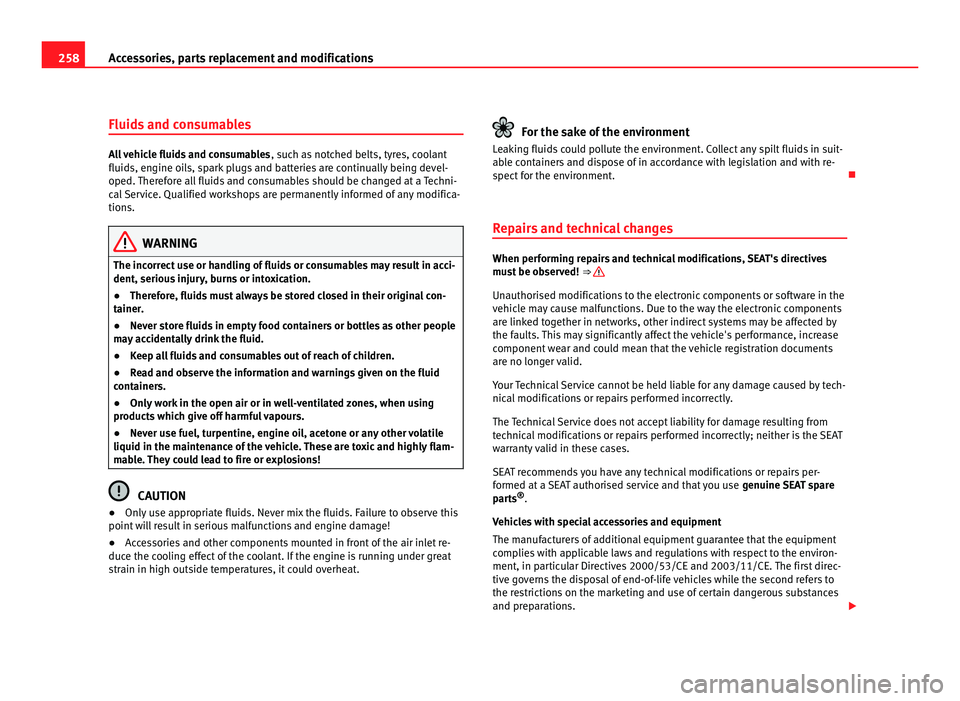
258
Accessories, parts replacement and modifications
Fluids and consumables All vehicle fluids and consumables
, such a s notched belts, tyres, coolant
fluids, engine oils, spark plugs and batteries are continually being devel-
oped. Therefore all fluids and consumables should be changed at a Techni-
cal Service. Qualified workshops are permanently informed of any modifica-
tions. WARNING
The incorrect use or handling of fluids or consumables may result in acci-
dent, serious injur
y, burns or intoxication.
● Therefore, fluids must always be stored closed in their original con-
tainer.
● Nev
er store fluids in empty food containers or bottles as other people
may
accidentally drink the fluid.
● Keep all fluids and consumables out of reach of children.
● Read and observe the information and warnings given on the fluid
container
s.
● Only work in the open air or in well-ventilated zones, when using
products
which give off harmful vapours.
● Never use fuel, turpentine, engine oil, acetone or any other volatile
liquid in the maint
enance of the vehicle. These are toxic and highly flam-
mable. They could lead to fire or explosions! CAUTION
● Only use appropriate fluids. Never mix the fluids. Failure to observe this
point w
ill result in serious malfunctions and engine damage!
● Accessories and other components mounted in front of the air inlet re-
duce the coo
ling effect of the coolant. If the engine is running under great
strain in high outside temperatures, it could overheat. For the sake of the environment
Leaking fluids could pollute the environment. Collect any spilt fluids in suit-
abl e c
ontainers and dispose of in accordance with legislation and with re-
spect for the environment.
Repairs and technical changes When performing repairs and technical modifications, SEAT's directives
mus
t
be observed! ⇒ Unauthorised modifications to the electronic components or software in the
vehic
l
e may cause malfunctions. Due to the way the electronic components
are linked together in networks, other indirect systems may be affected by
the faults. This may significantly affect the vehicle's performance, increase
component wear and could mean that the vehicle registration documents
are no longer valid.
Your Technical Service cannot be held liable for any damage caused by tech-
nical modifications or repairs performed incorrectly.
The Technical Service does not accept liability for damage resulting from
technical modifications or repairs performed incorrectly; neither is the SEAT
warranty valid in these cases.
SEAT recommends you have any technical modifications or repairs per-
formed at a SEAT authorised service and that you use genuine SEAT spare
parts ®
.
Vehicles with special accessories and equipment
The manufacturers of additional equipment guarantee that the equipment
complies with applicable laws and regulations with respect to the environ-
ment, in particular Directives 2000/53/CE and 2003/11/CE. The first direc-
tive governs the disposal of end-of-life vehicles while the second refers to
the restrictions on the marketing and use of certain dangerous substances
and preparations.